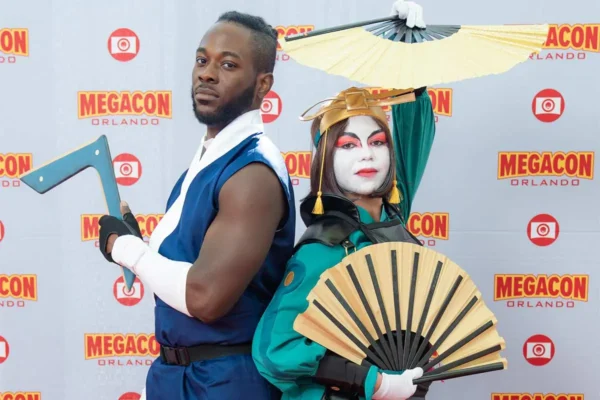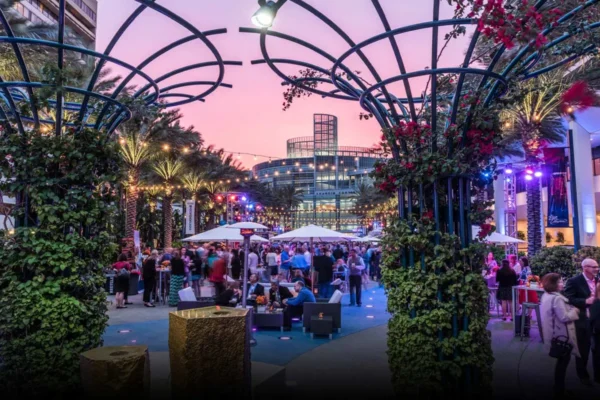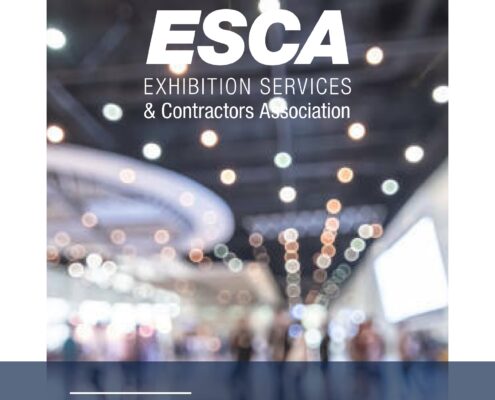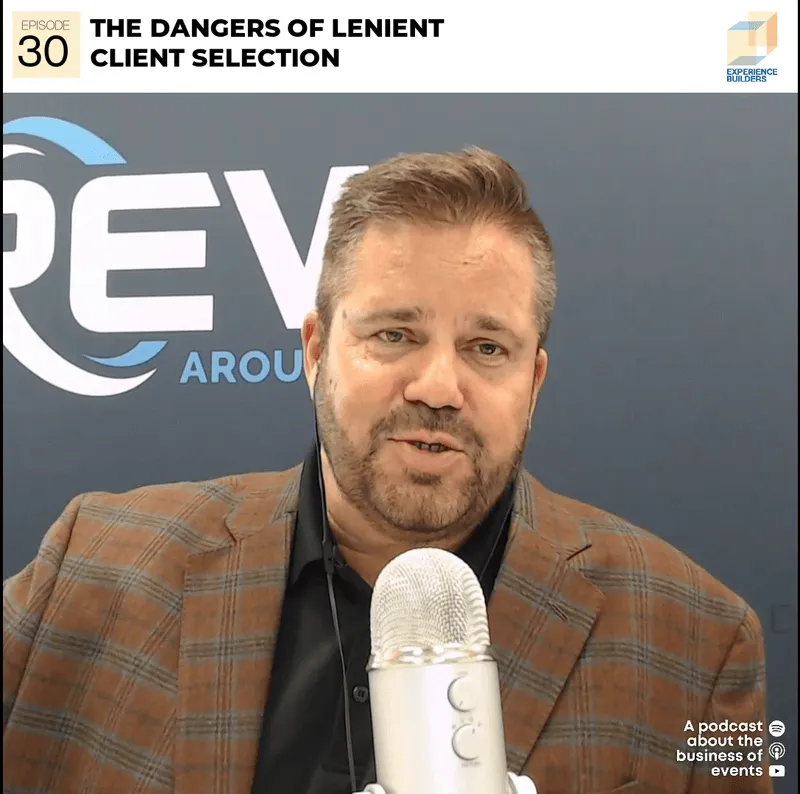(Photo Credit: Adam Ogden, JR Technical Services)
by Adam Ogden
In 2019, the U.S. tradeshow industry was a $5.5 billion industry that showcased an incredible amount of B2B growth, product unveilings and innovation across several different market segments. And before the global lockdowns, booth designs were becoming more elaborate, and technology became more central to these booths’ design themes. As many companies worked to increase the quality of their General Sessions, SKOs, and other client-facing meetings, so too have they worked to improve their tradeshow presence. In 2019, the average company budget for conferences and conventions was $1.3 million annually.
The ability to use technology in tradeshow booths can help spread the message in a variety of ways; whether it be a large touch-screen monitor that users can interact with to learn more about your product, a “silent presentation” audio system to help deliver a live demonstration to select participants, strategic lighting design to help focus the customers’ eyes on the product, or overhead digital signage to draw them to your booth.
Everyone is familiar with overhead signage at a tradeshow, the typical hoop-and-skirt fabric sign that hangs over the booth, drawing people in with its familiar logo and color scheme. These large fabric signs have been used for decades, and while they get the job done, they certainly have their limitations. You can solve these limitations—and in many cases with additional added benefits—using LED signage instead.
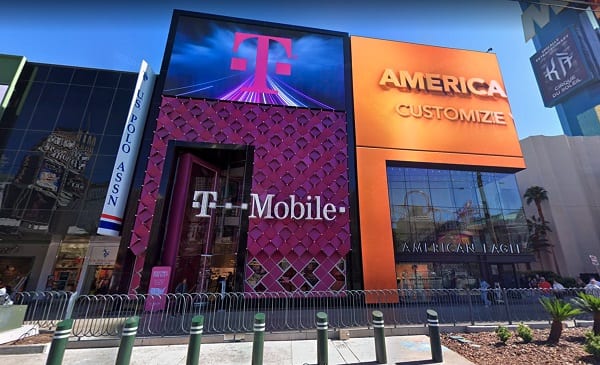 Digital signage—especially LED walls—has become a technology staple in marketing and advertising in a host of different applications, from retail marketing to highway advertising, and many opportunities in between. You can use these same strategies on the tradeshow floor to help draw potential customers to your booth. (Pictured right: The American Eagle store uses the entire façade of their building for marketing their products with bold HD colors, and high-impact visuals; while next door, T-Mobile uses a large LED wall as well.)
Digital signage—especially LED walls—has become a technology staple in marketing and advertising in a host of different applications, from retail marketing to highway advertising, and many opportunities in between. You can use these same strategies on the tradeshow floor to help draw potential customers to your booth. (Pictured right: The American Eagle store uses the entire façade of their building for marketing their products with bold HD colors, and high-impact visuals; while next door, T-Mobile uses a large LED wall as well.)
Let’s first look at some of the more apparent benefits of LED over fabric banners. LED walls are an actual light-emitting source, which means they are bright. Not shine-a-light-on-a-banner bright—I mean really bright. This means you have the opportunity to (literally) outshine your competition on the floor. Secondly, you have the invaluable opportunity to vary your content. Unlike a printed banner whose message remains the same from the time it leaves the printer until it is retired into the dumpster, LED content can change as often as you want. Imagine the opportunity to change or animate your logo or to add a simple motion background. Not only that, but you can make the content much more dynamic. For example, if your product is construction machinery, consider the impact of having a full-motion video of a new excavator doing its job (something that would be infeasible to do in a real-life booth space). Or perhaps you sell musical instruments, and you have a high-definition video of an orchestra playing. Imagine the visual impact of seeing 20 violin bows moving in unison, hanging 20 feet in the air, from across the show floor? The possibilities are endless.
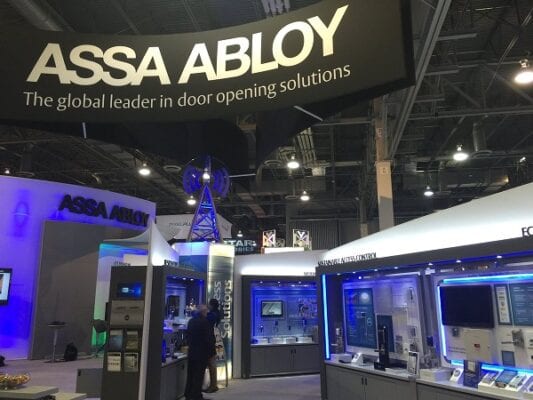 Assa Abloy utilized a black, three-sided fabric banner before switching to LED. After Assa Abloy switched to LED signs, they were able to use high-impact cityscapes that referenced whatever city they were exhibiting in, as well as 30-second “commercials” that played every hour.
Assa Abloy utilized a black, three-sided fabric banner before switching to LED. After Assa Abloy switched to LED signs, they were able to use high-impact cityscapes that referenced whatever city they were exhibiting in, as well as 30-second “commercials” that played every hour.
 “Weaving digital elements into our experiential marketing efforts is a priority for our team … It’s actually not as expensive as you would think as long as you work with trusted partners/vendors,” says Heidi Pascale, director of experiential marketing, Assa Abloy Door Security Solutions.
“Weaving digital elements into our experiential marketing efforts is a priority for our team … It’s actually not as expensive as you would think as long as you work with trusted partners/vendors,” says Heidi Pascale, director of experiential marketing, Assa Abloy Door Security Solutions.
In addition to these primary benefits of using LED, there are a few secondary benefits as well. They don’t necessarily fix a problem that fabric banners present, instead, these added benefits wouldn’t be possible at all with fabric banners. These benefits lean more towards the marketing aspect of tradeshows and not just merely signage.
Imagine you’ve created a raffle for your booth and have hyped it up over social media. The gimmick is “When you see the racecar speed across the screen sometime during the 2 o’clock hour, the raffle winner will be called” (or any visual cue you can imagine; fireworks, digital confetti, flashing lights, etc.) First, this drives traffic to your booth, as any good raffle does—especially if they are required to be present for the drawing. Secondly, it gives people a reason to continue looking at your screen, no matter where they are on the show floor. Lastly, because your booth stands out so much, people start using your booth as a landmark: “Meet me at (insert your name here) booth before lunch.” These are all marketing opportunities for your booth that cost you nothing additional (from a technical perspective) but can potentially yield extremely high returns.
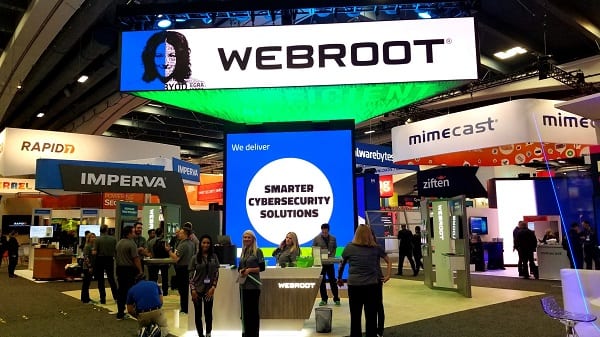 Let’s look at another marketing example. Imagine that a celebrity endorses your product, and they will be at your booth at 3 pm signing autographs. Think about all of the event-specific, high-impact branding opportunities you could utilize on the LED wall leading up to and during the signing to draw people towards your booth. The possibilities are limited only by your imagination. (Pictured left: LED options are endless. Not only did this booth use the triangular LED sign above their booth, but they also encased another floor-standing LED wall in their millwork for presentations within the booth. Photo credit: Adam Ogden, Any Venue Video)
Let’s look at another marketing example. Imagine that a celebrity endorses your product, and they will be at your booth at 3 pm signing autographs. Think about all of the event-specific, high-impact branding opportunities you could utilize on the LED wall leading up to and during the signing to draw people towards your booth. The possibilities are limited only by your imagination. (Pictured left: LED options are endless. Not only did this booth use the triangular LED sign above their booth, but they also encased another floor-standing LED wall in their millwork for presentations within the booth. Photo credit: Adam Ogden, Any Venue Video)
So, what are the drawbacks to using LED? Why aren’t more companies utilizing this technology? First, it’s an education issue—People don’t know what they don’t know. End-clients and booth builders alike need help recognizing the benefits of LED, so that they can reap the rewards. Secondly, it’s a colla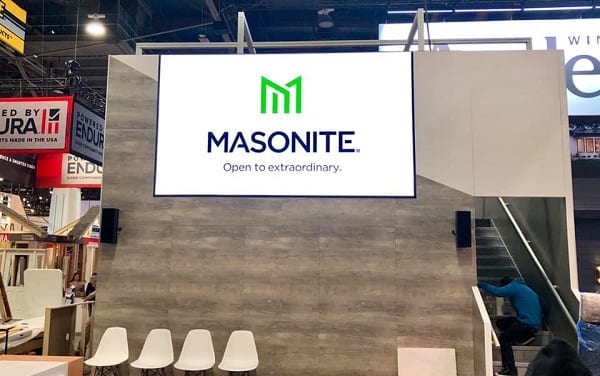 boration issue. Booth builders need to make money on their booths, and the more third party equipment they use, the less profit potential there is—primarily if a client works directly with an LED provider. But LED providers are always willing to work with the booth builders/designers to seamlessly integrate the LED technology into the booth design (pictured right, Photo Credit: Adam Ogden, Any Venue Video).
boration issue. Booth builders need to make money on their booths, and the more third party equipment they use, the less profit potential there is—primarily if a client works directly with an LED provider. But LED providers are always willing to work with the booth builders/designers to seamlessly integrate the LED technology into the booth design (pictured right, Photo Credit: Adam Ogden, Any Venue Video).
Another issue that can hinder LED (depending on the venue) is rigging capability. LED walls are certainly heavier than fabric banners, so the venue’s rigging structure might dictate that LED isn’t feasible. Lastly, the biggest adversary to using LED walls is the perceived cost difference. Like fabric banners, LED walls are built in various sizes and shapes, and each one of those variables affects the overall pricing. However, you quickly find that the value exceeds the cost when you factor in the variety of messaging opportunities that LED walls offer you.
The global lockdowns have undoubtedly slowed down the tradeshow industry—but the wheels are starting to turn again slowly. When things come back, people will pick up where they left off, and technological advances will continue to lead the way in booth design, information distribution and marketing opportunities. LED signage will be ready to point the way.
 Adam Ogden (pictured left) has been in the technical production industry for his entire life, starting as a volunteer at nine years old. Since then, Adam has been a technician or technical director for nonprofits, community events, fashion shows, corporate/hospitality AV, various design and installation firms, concerts/ touring, televised events, and galas/award shows. Currently, Adam is a technical director for InSync Production Services and Any Venue Video, based out of Las Vegas, NV. Contact him at aogden@3-insync.com.
Adam Ogden (pictured left) has been in the technical production industry for his entire life, starting as a volunteer at nine years old. Since then, Adam has been a technician or technical director for nonprofits, community events, fashion shows, corporate/hospitality AV, various design and installation firms, concerts/ touring, televised events, and galas/award shows. Currently, Adam is a technical director for InSync Production Services and Any Venue Video, based out of Las Vegas, NV. Contact him at aogden@3-insync.com.
An excerpt of this story originally appeared in the Mar./Apr. 2021 issue of Exhibit City News, p. 34. For original layout, visit https://issuu.com/exhibitcitynews/docs/ecn_mar-apr_2021












